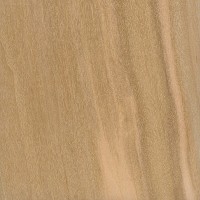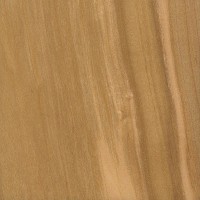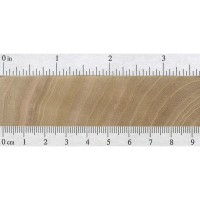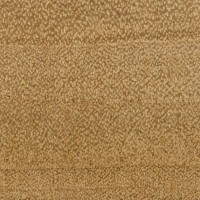 |
Common Name(s): Crack Willow Scientific Name: Salix fragilis Distribution: Native to Europe; also naturalized throughout North America Tree Size: 35-60 ft (10-18 m) tall, 2-3 ft (.6-1 m) trunk diameter Average Dried Weight: 27 lbs/ft3 (430 kg/m3) Specific Gravity (Basic, 12% MC): .34, .43 Janka Hardness: 640 lbf (2,830 N) Modulus of Rupture: 9,410 lbf/in2 (64.9 MPa) Elastic Modulus: 1,152,000 lbf/in2 (7.95 GPa) Crushing Strength: 3,530 lbf/in2 (24.4 MPa) Shrinkage:No data available |
Color/Appearance: Heartwood ranges from a light tan to a deeper reddish brown, sometimes with darker streaks. The sapwood is white to tan, and isn’t always clearly or sharply demarcated from heartwood.
Grain/Texture: Crack Willow has a straight grain with a fine to medium uniform texture.
Endgrain: Semi-ring-porous (very subtle change in pore size from earlywood to latewood sometimes overlooked as diffuse-porous); medium to large pores in no specific arrangement, moderately numerous to numerous; commonly in radial multiples of 2-3; narrow rays not visible—sometimes even with the aid of hand lens, spacing normal to close; parenchyma banded (marginal).
Rot Resistance: Rated as non-durable to perishable, and also susceptible to insect attack.
Workability: With its low density, Crack Willow can have poor machining characteristics, frequently resulting in fuzzy surfaces during planing. Willow also tends to develop numerous drying defects and can be difficult to season. Glues and finishes well.
Odor: No characteristic odor.
Allergies/Toxicity: There have been very few adverse health effects associated with the actual wood of willow (Salix genus), however, the bark and other parts of the tree have been reported as sensitizers. Usually most common reactions simply include skin and respiratory irritation. See the articles Wood Allergies and Toxicity and Wood Dust Safety for more information.
Pricing/Availability: Crack Willow isn’t seen for sale very often in the United States because other domestic species, (such as Black Willow), are more readily available. Prices within its natural range are likely to be moderate.
Sustainability: This wood species is not listed in the CITES Appendices or on the IUCN Red List of Threatened Species.
Common Uses: Baskets, utility wood, crates, furniture, carvings, and other small specialty wood items.
Comments: Crack Willow is so-named because of its branches and twigs, which are easily broken from the tree, resulting in a cracking sound. Willow is a lightweight hardwood with good shock resistance, but overall is weak for its weight. These characteristics, coupled with its sub-par workability, restrict willow to mostly rough, utilitarian purposes.
None available.
Scans/Pictures: A special thanks to Steve Earis for providing the wood sample of this wood species.








I will take a photo in next few days to share, my dad went back to work yesterday and got a lot of compliments (works at Microsoft data center) and when I was getting it ready to give to him anybody that saw it just had to come and ask what I was doing with that incredible looking stick. It has a handle just like a cane, but grew that way on it’s own. And just gorgeous colors.
Makes for excellent walking sticks and canes even after borrowing bugs had come and gone and the branch was grey and black atop Washington states largest crack willow for 30 years then sawed off and under a pile of huge branches that could’ve easily flattened a person. Washed it with super clean and water really quick l, let it dry soaked it with warm coconut oil and it was like magic from grey to glowing. Is just a little bit smaller in diameter then the average cane and my dad is using it just fine after a full hip replacement-… Read more »